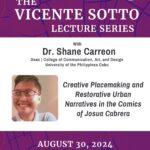 Vicente Sotto Lecture Series
Vicente Sotto Lecture Series

Vicente Sotto Lecture 2025 January
“Toward a Camino de Santo Niño” Mr. Jason Abellaneda Baguia ABSTRACT: The devotion to the Holy Child Jesus of Cebu is at least 460 years old as of 2025, the ordinary jubilee year of the Catholic Church that unfolds with the theme “Pilgrims in Hope.” Drawing from the theme of pilgrimage and from famous pilgrimage […]

Vicente Sotto Lecture 2024 December
“Seizing the Momentum: The Communist Resistance in Cebu during the Anti-Marcos Struggle, 1972–1986” Mr. Karlo Mikhail I. Mongaya ABSTRACT: The talk makes use of archival material and oral narratives to retrieve the history of the communist resistance to the Marcos regime in Cebu from 1972 to 1986, focusing on one of the Philippines’ major urban […]

Vicente Sotto Lecture 2024 November
“The Making of a Legend: Shaman-warrior Narratives of Cebu” Ms. Maricris Lauro-Henderson ABSTRACT: The variations of the shaman-warrior narratives deserve examination. These narratives share magically endowed characters who are invulnerable (kublan or pabukol) and can fly (e.g. stand on the tip of a banana or cogon leaf). The narratives at times tax credulity and the […]

Vicente Sotto Lecture 2024 October
“Slay That Move: Tourism and Rehabilitation of the Dancing Inmates of the Cebu Provincial Detention Rehabilitation Center, Philippines” Mr. Emmanuele Jones Mante ABSTRACT OF THE LECTURE: This research is a descriptive analysis of the dancing inmates in Cebu City, Philippines, particularly at the Cebu Provincial Detention and Rehabilitation Center (CPDRC). The CPDRC gained prominence by […]

Vicente Sotto Lecture 2024 September
“Tambag, Tigmo, Tusmod: Reading Cebuano Riddles and Dares in Selected Poems by Michael Obenieta” Dr. Desiree L. Balota ABSTRACT: This paper explores the communication of intentions, intimations, and imperatives in selected poems of Michael U. Obenieta. With attention to the socio-cultural tradition in Robert Craig’s communication theory and Max Weber’s and George Herbert Mead’s symbolic […]

Vicente Sotto Lecture 2024 August
“Creative Placemaking and Restorative Urban Narratives In the Comics of Josua Cabrera” Dr. Shane Carreon ABSTRACT: The paper is a preliminary look into the visualization of Cebu City by poet and cartoonist Josua Cabrera as shown in his comic strips, Latagaw og Utok and Jimsky and his forthcoming graphic novel, Si Jimsky ug ang Tanghaga […]

Vicente Sotto Lecture 2024 July
“Gugma sa Yutang Natawhan: Recontextualizing Vicente Sotto’s sense of nation in his journalistic fiction amid current challenges to Philippine Sovereignty,” Dr. Crina E. Tañongon ABSTRACT: Following the Philippines’ independence from American colonial rule in 1946, questions persist regarding the nation’s true sovereignty, especially amidst ongoing territorial disputes in the West Philippine Sea with China. This […]

Vicente Sotto Lecture 2024 June
“A Panorama of Fools in the Plays of Piux Kabahar” Dr. Hope Sabanpan-Yu ABSTRACT: Studies devoted solely to methods of characterization in Philippine dramatic plays have been relatively few. In addition to language, the playwright Piux Kabahar presents odd characters, those with offbeat thoughts and behaviors. A reading of Kabahar’s comic plays will yield a […]

Vicente Sotto Lecture 2024 May
“Tapping AI, Big Data Tools, and Archives to Track Missing Cebuano Heritage” Max T. Limpag ABSTRACT: New technologies such as AI augment the capabilities of journalists and researchers in processing huge amounts of documents and data and extract insights needed for reporting and writing. The recent issue on heritage allegedly stolen from parishes in Cebu […]

Vicente Sotto Lecture 2024 April
“The Forgotten Avila Paintings in the Convent of Boljoon: Reexamining the Stylistic and Formal Qualities of the Ceiling Paintings of the Convent of Boljoon and its Re-attribution as a Work by the Prewar Cebuano Painter, Canuto Avila” Jay Nathan T. Jore ABSTRACT: The talk will center around the prewar movement in Cebuano art of decorating […]
